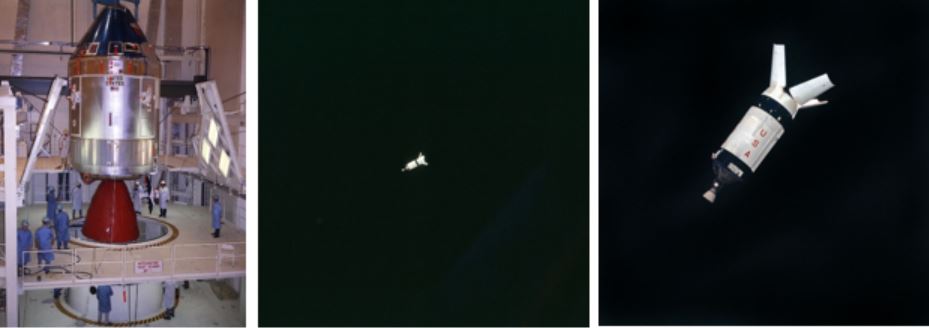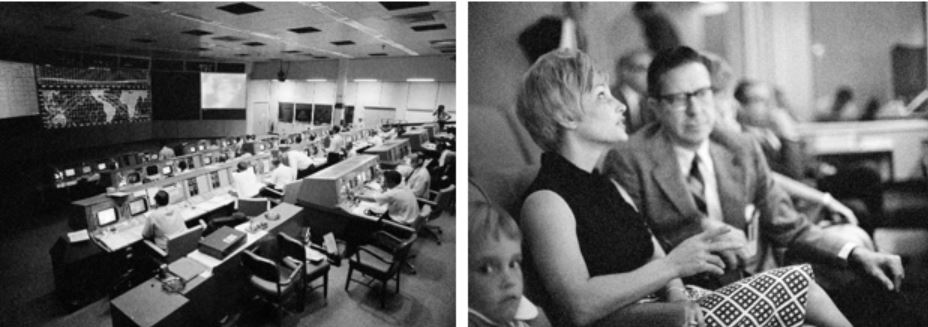The Apollo 7 crew of Walter M. Schirra, Donn F. Eisele, and R. Walter Cunningham spent a very busy first day in space, starting with their launch from Cape Kennedy on October 11, 1968, returning Americans to space for the first time in 23 months. They separated their Command and Service Module from the S-IVB second stage and completed the transposition and docking maneuver, then flew their spacecraft to a distance of 80 miles to prepare for the rendezvous maneuver the next day. The only sour note of the first day was that all three came down with head colds, which in weightlessness is much more of a nuisance than on the ground. Flight surgeons advised the crew to take decongestants to alleviate their symptoms.
In Mission Control at the Manned Spacecraft Center, now the Johnson Space Center in Houston, three teams of controllers, led by Lead Flight Director Glynn S. Lunney and Flight Directors Eugene F. “Gene” Kranz and Gerald D. Griffin, closely monitored the rendezvous in eight-hour shifts. Early in the day, they passed along messages of congratulations from President Lyndon B. Johnson and Vice President Hubert H. Humphrey. Cunningham’s wife Lo visited Mission Control in the morning with their two children, Bryan and Kimberly.
On orbit, Schirra, Eisele, and Cunningham prepared for the rendezvous with the S-IVB stage. The maneuver would include the first two of the mission’s planned eight burns of the spacecraft’s Service Propulsion System (SPS). The engine, built by the Aerojet General Corporation, had a thrust of 21,000 pounds and was planned to be used on later missions to insert the Apollo spacecraft into and out of lunar orbit. It was therefore a critical component of the lunar landing program and the Apollo 7 crew thorouoghly tested it during their mission. To focus on the preparation for the SPS burns, Schirra informed Mission Control that they would be cancelling the first television downlink event planned to occur prior to the first engine firing. It was rescheduled for Flight Day (FD) 4.
At 26 hours 25 minutes into the flight, the SPS engine lit as planned. The force of the engine firing was stronger than the crew anticipated, pressing them back into their couches. Schirra exuberantly called down to Mission Control, “Yabadabadoo!” quoting Fred Flintstone from the popular television cartoon series. He added, “Great, man! That’s like a ride and a half! … That’s a real kick in the center. That really socks it to you.” The engine fired for 9.36 seconds in the first step of the rendezvous maneuver, followed about 90 minutes later by the second SPS burn lasting just under 8 seconds. Both burns were completed as planned. The chase to the S-IVB was on.
The crew used the Service Module’s Reaction Control System (RCS) thrusters to complete the rendezvous. As they approached the S-IVB to about 70 feet, Schirra reported to Mission Control that “it’s tumbling rather wildly, so we are starting to stay away from it.” Cunningham noted that the one Spacecraft LM Adapter panel that was only partially deployed on the first day was now fully deployed. After station keeping for about 25 minutes, they fired the RCS thrusters to separate from the S-IVB for the final time. They continued to track the stage through the remainder of the day using their spacecraft’s sextant, out to a distance of 184 miles, an activity they continued into Flight Day 3.
By the end of the second day, about 90% of the mission’s primary objectives had been met. The crew still had more than a week left in their mission, with six additional SPS engine firings, several TV downlinks, and additional tests of spacecraft systems.






























